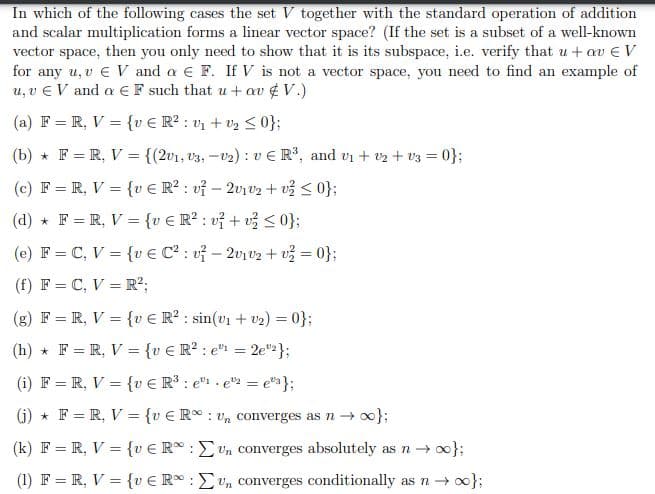(d) F = R, V = {ve R²: v+v ≤ 0}; * (e) F = C, V = {ve C²: v² - 2v₁v2 + ² = 0}; (f) F= C, V = R²;
(d) F = R, V = {ve R²: v+v ≤ 0}; * (e) F = C, V = {ve C²: v² - 2v₁v2 + ² = 0}; (f) F= C, V = R²;
Linear Algebra: A Modern Introduction
4th Edition
ISBN:9781285463247
Author:David Poole
Publisher:David Poole
Chapter6: Vector Spaces
Section6.4: Linear Transformations
Problem 34EQ
Related questions
Question
part D E F

Transcribed Image Text:In which of the following cases the set V together with the standard operation of addition
and scalar multiplication forms a linear vector space? (If the set is a subset of a well-known
vector space, then you only need to show that it is its subspace, i.e. verify that u + av € V
for any u, v € V and a € F. If V is not a vector space, you need to find an example of
u, v EV and a EF such that u + av V.)
(a) F= R, V = {v € R²: v₁ + 0₂ ≤ 0};
(b) F=R, V = {(2v1, 3, -₂): vE R³, and v₁ + 2 + V3 = 0};
(c) F= R, V = {v € R²: v² - 2v1v2 + v² ≤0};
(d) F = R, V = {v € R²: v² + v² ≤ 0};
(e) F = C, V = {v € C²: v² - 2v₁v₂ + v² = 0};
(f) F = C, V = R²;
(g) F = R, V = {v € R²: sin(v₁ + ₂) = 0};
(h) F= R, V = {v € R²: e¹¹ = 2e2};
(i) F= R, V = {v € R³: e¹e¹2 = e" };
(j) F= R, V = {ve Run converges as no};
(k) F= R, V = {ve Run converges absolutely as n → ∞};
(1) F= R, V = {vER: un converges conditionally as n → ∞0};
Expert Solution
This question has been solved!
Explore an expertly crafted, step-by-step solution for a thorough understanding of key concepts.
Step by step
Solved in 3 steps with 3 images

Recommended textbooks for you

Linear Algebra: A Modern Introduction
Algebra
ISBN:
9781285463247
Author:
David Poole
Publisher:
Cengage Learning

Elementary Linear Algebra (MindTap Course List)
Algebra
ISBN:
9781305658004
Author:
Ron Larson
Publisher:
Cengage Learning

Linear Algebra: A Modern Introduction
Algebra
ISBN:
9781285463247
Author:
David Poole
Publisher:
Cengage Learning

Elementary Linear Algebra (MindTap Course List)
Algebra
ISBN:
9781305658004
Author:
Ron Larson
Publisher:
Cengage Learning